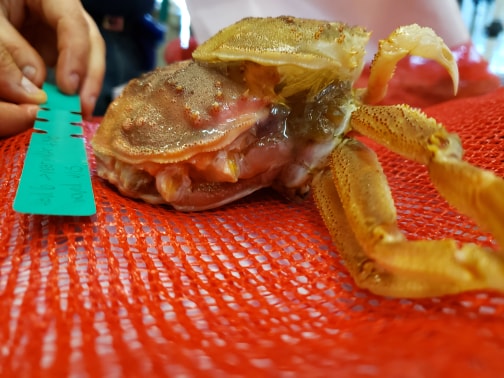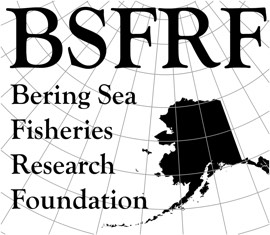 BSFRF is continuing its research into the growth rate of Tanner and snow crab in order to better inform the crab stock assessment models used in harvest management decisions. This project is a continuing effort, building on prior years’ sampling and growth monitoring. Our research team, which was led by Madison Shipley, BSFRF/NRC and included Erin Fedewa of NOAA (Kodiak), and Charles Heller, BSFRF/NRC, returned in April from a ten-day sampling trip to capture pre-molt Tanner and snow crab around the Pribilof Islands. The study is looking at how much crab grow between molts and to improve upon the limited samples of growth per molt that are available from Bering Sea crabs.
BSFRF is continuing its research into the growth rate of Tanner and snow crab in order to better inform the crab stock assessment models used in harvest management decisions. This project is a continuing effort, building on prior years’ sampling and growth monitoring. Our research team, which was led by Madison Shipley, BSFRF/NRC and included Erin Fedewa of NOAA (Kodiak), and Charles Heller, BSFRF/NRC, returned in April from a ten-day sampling trip to capture pre-molt Tanner and snow crab around the Pribilof Islands. The study is looking at how much crab grow between molts and to improve upon the limited samples of growth per molt that are available from Bering Sea crabs.
We were operating onboard the F/V Half Moon Bay under charter to complete the growth sample collections. We used a specialized Nephrops trawl which can capture very small-sized crabs while maintaining optimum contact with the sea bottom. We completed 34 trawl tows, capturing several thousand crabs, and retained 464 crab samples within targeted size classes between 15 mm and 105 mm. After capture, crabs were sorted to retain only “pre-molt” crabs which were held in small-mesh bags in tanks on deck during the charter. After return to port, crab were transported to the Kodiak NOAA shellfish laboratory and placed individually into stacked plastic containers. Crabs were then monitored daily for molting. Once a molt occurs, the old carapace and the newly formed carapace widths are measured and the growth increment is recorded.
The growth per molt of both Bering Sea snow crab, Chionoecetes opilio , and southern Tanner crab, Chionoecetes bairdi , has proven to be a critical poplulation parameter that informs the annual status estimates of these crab stocks. Improving the understanding of growth for the snow and Tanner crab is expected to improve the stock assessments, management, and sustainability of these commercially important stocks over time. This research is another example of how BSFRF works with our research partners to improve the science of crab management in the Bering Sea.
